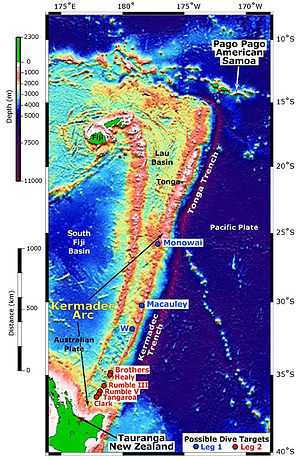Kermadec Trench

The Kermadec Trench is one of Earth's deepest oceanic trenches, reaching a depth of 10,047 metres (32,963 ft). Formed by the subduction of the Pacific Plate under the Indo-Australian Plate, it runs over a thousand kilometres parallel with and to the east of the Kermadec Ridge and island arc, from near the northeastern tip of New Zealand's North Island to the trench's junction with the Louisville seamount chain northeast of Monowai Seamount. The Tonga Trench marks the continuation of subduction beyond this point. Subduction south of the Kermadec Trench is marked by the shallower Hikurangi Trench.
The Kermadec Trench is noted for its very abrupt slope.
In May 2014, the Nereus, an unmanned research submarine operated by the Woods Hole Oceanographic Institution (WHOI), was destroyed by a "catastrophic implosion" at a depth of 9.99 kilometres while exploring the Kermadec Trench.[1]
Fauna
In 2012, deep sea researchers discovered individuals of a species of giant amphipod at the trench's lowest depths.[2] Unlike most amphipods, which are approximately 2.5 cm (1 inch) long, this species reaches up to 34 cm (13 inches) in length, and are milky-white.[2]
See also
References
- ↑ "Nereus, unmanned research sub, suffers 'catastrophic implosion' nearly 10 kilometres underwater". National Post (Toronto). Associated Press. 12 May 2014. Retrieved 13 May 2014.
- ↑ 2.0 2.1 Morelle, Rebecca (2 February 2012). "'Supergiant' crustacean found in deepest ocean". BBC News. Retrieved 13 May 2014.
| ||||||||||||||||||||||||||